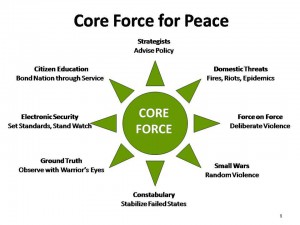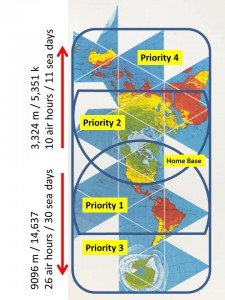
Washingtonpost.com, March 29, 2013
Drawing Down, But Still Projecting Power
By David Ignatius
TAMPA–The emblem of the U.S. Special Operations Command pointedly illustrates its mission: It shows the tip of a spear. Now SOCOM is expanding this arsenal to create a global network that can project power even as America's armies withdraw from the battlefields of the last decade.
Adm. William McRaven, the SOCOM commander, has been developing this ambitious new role at his headquarters at MacDill Air Force Base here. McRaven is among the nation’s most celebrated warriors. He planned the operation that killed Osama bin Laden in May 2011; in his office is a small sculpture tagged “Bull Frog,” honoring him as the longest-serving Navy SEAL in uniform.
McRaven’s plan to create a “global SOF network” was endorsed in February by the Pentagon, which gave McRaven direct control over special operations forces around the world. The move appears to have support from other top military commanders, even though it would potentially diminish their authority. But there has been little public discussion of the policy, despite its significant changes. The White House appears to like the concept but has not signed off on final details.
The underlying idea is that special forces have proved themselves America’s best weapon against extremists in a turbulent, increasingly borderless world. After the grinding wars in Iraq and Afghanistan, the United States won’t be sending big expeditionary armies abroad anytime soon. America’s heavyweight commands, such as U.S. Central Command in the Middle East and U.S. Pacific Command in Asia, will now focus on potentially adversarial nations such as Iran, China and North Korea.
To fight the small wars, McRaven offers his agile, stealthy and highly lethal network of commandos. Often their missions will involve training and partnering with other nations, rather than shooting. Sometimes, their activities may look like USAID development assistance or CIA political action.
McRaven’s global network would help fill a vacuum in U.S. foreign policy. As America retreats from its costly and unpopular wars, it needs ways to influence a world shaken by what former national security adviser Zbigniew Brzezinski calls the “global political awakening.” The United States also needs to get its act together bureaucratically — coordinating military services and government agencies the way SOCOM has done with its joint forces.
The existing tool kit hasn’t been very effective: USAID is more of a development contractor than an operational agency; the State Department’s Bureau of Conflict and Stabilization Operations is too small to lead even its own department’s efforts, let alone the government’s; the U.S. Institute of Peace likes its status as an independent adviser, rather than an instrument of national power. And the CIA wants to do less covert action, not more.
Enter the Special Operations Forces. The past decade may have shown the limits of conventional military power, but it has also demonstrated the potency of the unconventional SOF arsenal. The most dramatic examples are the secret task forces that killed bin Laden in Pakistan and targeted hundreds of other extremists in night raids in Iraq and Afghanistan.
McRaven’s staff argues that the biggest future impact of special forces may not be in combat but in partnering and networking. An example is the “A-teams” that lived rough with Afghan tribal fighters starting in 2001 and made them partners against the Taliban. The network will draw on SOCOM forces deployed in 78 countries, many teaching war-fighting skills to local special forces. In a pamphlet describing the plan, McRaven’s warriors are pictured mentoring elite forces from Thailand, Nigeria, Albania, Colombia, Jordan and a dozen other countries. That’s the network, in embryo.
SOCOM planners say the concept was conceived in Europe in 2007, where McRaven created a NATO center that boosted European special forces in Afghanistan from 340 in 2007 to 2,200 now. Fighting together, they formed what commanders hope will be lasting bonds. As one of the SOCOM slogans has it: “You can’t surge trust.”
The idea of filling the power gap with special forces is appealing, but I come away with this caution: The world is wary of forward-deployed U.S. commandos, no matter how important the mission. A decade ago, a Pentagon plan to spread special forces abroad as “military liaison elements” created a firestorm of protest. McRaven may promise that his network won’t act anywhere without the approval of the U.S. ambassador, but the State Department will still have the jitters, not to mention foreign governments.
A global SOF network will be a powerful tool, but it can’t fill the vacuum by itself. SOF power and soft power aren’t the same thing.

Phi Beta Iota: In 1997, when General Peter Schoomaker was CINCSOC, there was discussion of White SOF having its own three-star deputy. When Army elevated Col Ferd Irizzary to Brigadier — the first active duty Civil Affairs Branch officer promoted to flag in modern history — there was some hope that we might be moving in that direction. All indicators are that White SOF is dead in the water because Big Army refuses to rethink its assumptions and reconfigure, instead choosing to fight the budget share game. Also in the 1990's there was discussion of the need for the military to become a “Core Force” providing mobility, C4I, and the architecture for projecting multinational whole of government soft power all over the world. This was even briefed at the George Marshall Center in Germany in about 1997. We have wasted 20 years while the mandarins have refused to adapt to reality — they seem bent on not just sinking the ship of state, but taking everyone down with them. Four things need to happen in the near-term if the USA is to get back on track in a global context:

01 Aggressively expand White SOF, appointing a 3 star deputy to CINCSOC for White SOF, and creating an archtecture for surging multinational civilian and military around a core team with a White SOF mind-set, not a Black SOF mind-set.
02 Articulate a proper strategy that justifies a 450-ship Navy, a long-haul Air Force, and an air-liftable Army, while reducing the Marine Corps to two combined arms brigades that are totally maritime in nature. In tandem, begin aggressively drawing back from overseas and closing down the theater commands. At the same time, flush the Country Teams — the Embassies are outrageously over-staffed and need to be sharply cut back, while also removing secret capabilities from official installations, and putting in inter-agency analytic teams with funding for open source acquisition in place of the discarded faux clandestine officers.
03 Create the Open Source Agency (OSA) as an element of the Executive Office of the President, perhaps reporting to the new Deputy Director for Management in the Office of Management and Budget.
04 Encourage the new commander of NATO to fully explore the concepts of Information Peacekeeping and Peacekeeping Intelligence while adopting the White SOF / Core Force approach to all interventions, and support the creation of a South Atlantic Treaty Organization, closing down the Organization of American States and turning the building over to CELAC (Community of Latin American and Caribbean States). Embrace the Hourglass Strategy and start making ethical evidence-based decisions in a whole systems true cost economics context.



